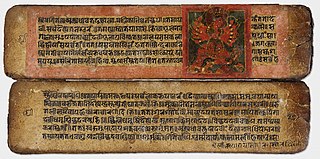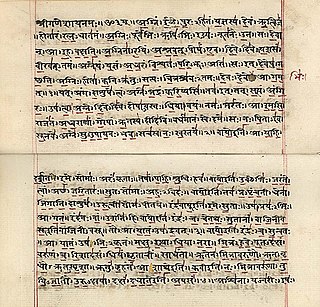
Indra is the king of the devas and Svarga (heaven) in Hindu mythology. He is associated with the sky, lightning, weather, thunder, storms, rains, river flows, and war. Indra's myths and powers are similar to other Indo-European deities such as Jupiter, Perun, Perkūnas, Zalmoxis, Taranis, Zeus, and Thor, part of the greater Proto-Indo-European mythology.

In Hinduism, the Maruts, also known as the Marutagana and sometimes identified with Rudras, are storm deities and sons of Rudra and Prisni. The number of Maruts varies from 27 to sixty. They are very violent and aggressive, described as armed with golden weapons i.e. lightning and thunderbolts, as having iron teeth and roaring like lions, as residing in the northwest, as riding in golden chariots drawn by ruddy horses.

Angiras or Angira was a Vedic rishi (sage) of Hinduism. He is described in the Rigveda as a teacher of divine knowledge, a mediator between men and gods, as well as stated in other hymns to be the first of Agni-devas. In some texts, he is considered to be one of the seven great sages or Saptarishis, but in others he is mentioned but not counted in the list of seven great sages. In some manuscripts of Atharvaveda, the text is attributed to "Atharvangirasah", which is a compound of sage Atharvan and Angira. The student family of Angira are called "Angira", and they are credited to be the authors of some hymns in the first, second, fifth, eighth, ninth, and tenth books of the Rigveda. By the time of the composition of the Rigveda, the Angirases were an old Rishi clan, and were stated to have participated in several events.

Atri or Attri is a Vedic sage, who is credited with composing numerous hymns to Agni, Indra, and other Vedic deities of Hinduism. Atri is one of the Saptarishi in the Hindu tradition, and the one most mentioned in its scripture Rigveda.

Bharadvaja was one of the revered Vedic sages (maharishi) in Ancient India. He was a renowned scholar, economist, grammarian and physician. He is one of the Saptarishis.

Sanskrit literature broadly comprises all literature in the Sanskrit language. This includes texts composed in the earliest attested descendant of the Proto-Indo-Aryan language known as Vedic Sanskrit, texts in Classical Sanskrit as well as some mixed and non-standard forms of Sanskrit. Literature in the older language begins with the composition of the Ṛg·veda between about 1500 and 1000 BCE, followed by other Vedic works right up to the time of the grammarian Pāṇini around 6th or 4th century BCE.

Terminalia bellirica, known as baheda, bahera, behada, beleric or bastard myrobalan, Persian بلیله (Balileh), Sanskrit: Bibhitaka बिभीतक, Aksha अक्ष) is a large deciduous tree in the Combretaceae family. It is common on the plains and lower hills in South and Southeast Asia, where it is also grown as an avenue tree. The basionym is Myrobalanus bellirica Gaertn.. William Roxburgh transferred M. bellirica to Terminalia as "T. bellerica (Gaertn.) Roxb.". This spelling error is now widely used, causing confusion. The correct name is Terminalia bellirica (Gaertn.) Roxb.
Tvashtr or Tvashta is a Vedic artisan god or fashioner. He is mentioned as an Aditya in later Hindu scriptures like the Mahabharata and Puranas, though his significance gets reduced. Tvashtr is sometimes identified with another artisan deity named Vishvakarma.
Vedic metre refers to the poetic metre in the Vedic literature. The study of Vedic metre, along with post-Vedic metre, is part of Chandas, one of the six Vedanga disciplines.

The Ashvins, also known as the Ashvini Kumaras and Asvinau, are Hindu twin gods associated with medicine, health, dawn, and the sciences. In the Rigveda, they are described as youthful divine twin horsemen, travelling in a chariot drawn by horses that are never weary, and portrayed as guardian deities that safeguard and rescue people by aiding them in various situations.

The Bharatas were an early Vedic tribe that existed in the latter half of the second millennium B.C.E.
The Mahamrityunjaya Mantra, also known as the Rudra Mantra or Tryambakam Mantra, is a verse (ṛc) of the Rigveda. The ṛc is addressed to Tryambaka, "The Three-eyed One", an epithet of Rudra who is identified with Shiva in Shaivism. The verse also recurs in the Yajurveda.
Dadhikrā or Dadhikrāvan was likely the racehorse or warhorse selected for the Aśvamedha of King Trasadasyu, who ruled the Rigvedic Pūru tribe. Trasadasyu had led the Pūru eastward across the Sindhu river and there defeated the Anu-Druhyu and Yadu-Turvaśa tribal unions. The ritual would thus have been meant to strengthen Trasadasyu's royal legitimacy and signal the Pūru's newly preeminent position among the neighboring Aryan tribes.

The Vedic period, or the Vedic age, is the period in the late Bronze Age and early Iron Age of the history of India when the Vedic literature, including the Vedas, was composed in the northern Indian subcontinent, between the end of the urban Indus Valley civilisation and a second urbanisation, which began in the central Indo-Gangetic Plain c. 600 BCE. The Vedas are liturgical texts which formed the basis of the influential Brahmanical ideology, which developed in the Kuru Kingdom, a tribal union of several Indo-Aryan tribes. The Vedas contain details of life during this period that have been interpreted to be historical and constitute the primary sources for understanding the period. These documents, alongside the corresponding archaeological record, allow for the evolution of the Indo-Aryan and Vedic culture to be traced and inferred.
Sanskrit prosody or Chandas refers to one of the six Vedangas, or limbs of Vedic studies. It is the study of poetic metres and verse in Sanskrit. This field of study was central to the composition of the Vedas, the scriptural canons of Hinduism, so central that some later Hindu and Buddhist texts refer to the Vedas as Chandas.
The Bṛhaddevatā, is a metrical Sanskrit work, traditionally ascribed to Shaunaka. It is an enlarged catalogue of the Rigvedic deities worshipped in the individual suktas (hymns) of the Rigveda. It also contains the myths and legends related to the composition of these suktas.
The Gāhā Sattasaī or Gāhā Kośa is an ancient collection of Indian poems in Maharashtri Prakrit language. The poems are about love. They are written as frank monologues usually by a married woman, or an unmarried girl. They often express her unrequited feelings and longings to her friend, mother or another relative, lover, husband or to herself. Many poems are notable for describing unmarried girls daring for secret rendezvous to meet boys in ancient India, or about marital problems with husbands who remains emotionally a stranger to his wife and bosses over her, while trying to have affairs with other women.

The Rigveda or Rig Veda is an ancient Indian collection of Vedic Sanskrit hymns (sūktas). It is one of the four sacred canonical Hindu texts (śruti) known as the Vedas. Only one Shakha of the many survive today, namely the Śakalya Shakha. Much of the contents contained in the remaining Shakhas are now lost or are not available in the public forum.

The Subala Upanishad, also called Subalopanishad (सुबालोपनिषत्), is an Upanishad written in Sanskrit. It is attached to the Shukla Yajurveda, and classified as one of the Samanya Upanishads of Hinduism.

The Suparṇākhyāna, also known as the Suparṇādhyāya, is a short epic poem or cycle of ballads in Sanskrit about the divine bird Garuda, believed to date from the late Vedic period. Considered to be among the "earliest traces of epic poetry in India," the text only survives "in very bad condition," and remains "little studied."












